
-
@chef Yep. Zebra is incremental in 5% steps - 70% no problems. Anything below 50% isn't really worth Zebra'ing. One can adjust the point at which the zebra pattern starts and stops from 50-105% in 5% steps.
GH4 uses Hi Profile Level 5.1 at 4096x2160 C4K
Very impressed with rolling shutter - best Ive seen from Pany Lumix G series. Jello appears minimal.
Approx 90 minutes of 4K recording at C4k 24p h264 mov @ 100Mbps on a 64Gb card. No problems recording on a SanDisk 64GB / 95MB/s SDXC 1 card @ 100Mbps REC modes.
Zero overheating issues.
Below: A few GH4 to 4K monitoring pics in action.
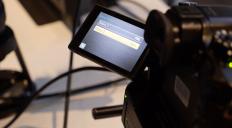
 GH4zebra_at_70%.jpg1722 x 952 - 606K
GH4zebra_at_70%.jpg1722 x 952 - 606K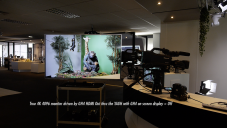
 4k hdmi output with GH4 display = off.png1080 x 608 - 877K
4k hdmi output with GH4 display = off.png1080 x 608 - 877K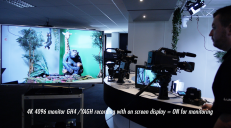
 display = on gh4 thru the yagh to 4k monitoring.png1080 x 598 - 929K
display = on gh4 thru the yagh to 4k monitoring.png1080 x 598 - 929K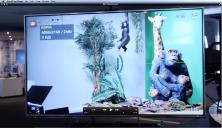
 Full 4K gh4 4096 at 24Hz.png1080 x 622 - 885K
Full 4K gh4 4096 at 24Hz.png1080 x 622 - 885K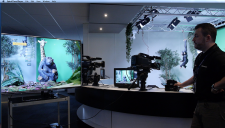
 mark baber of panasonic UK puts the gh4 thru its paces.png1080 x 614 - 999K
mark baber of panasonic UK puts the gh4 thru its paces.png1080 x 614 - 999K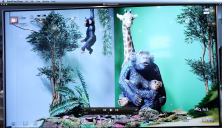
 gh4 focus peak check.png1080 x 622 - 1M
gh4 focus peak check.png1080 x 622 - 1M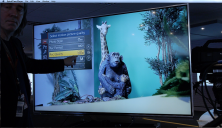
 driftwood at zoo panasonic.png1080 x 623 - 975K
driftwood at zoo panasonic.png1080 x 623 - 975K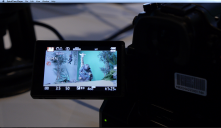
 GH4 - approx 90 minutes of recording at c4k on a 64Gb card.png1080 x 626 - 676K
GH4 - approx 90 minutes of recording at c4k on a 64Gb card.png1080 x 626 - 676K -
@Mistas @duartix I've been wondering about stabilizing 4k as well. If you listen to the extra features on the last couple David Fincher movies (Dragon Tattoo, Social Network), the editors and vfx people talk about how Fincher will shoot a dolly shot or a pan to maximize the smoothness of it, but STILL stabilize it again in post. I've always wondered how that jibes with not having the obvious artifacts one gets from motion blur being cancelled out via stabilization. Shooting on cameras without a rolling shutter would help to some extent, but it still seems like you'd be able to see something there, yet I don't notice it at all in his films. Maybe because the post stabilize is only doing a minor correction and the camera is kept very stable during production.
-
Some originals clips founded on vimeo:
The first one is the most interesting to watch something more about dynamic range and gamma.
-
Seeing a trace of stair stepping on the Arri Alexa vid.
-
@aahbleza - it's a shame they never bothered to bring the alexa out of log, but watching this on YouTube, the resolution of the GH4 is gorgeous
-
@mrbill : The Warp Stabilizer was introduced as a filter in After Effects 5.5 and Premiere CS6. From my experience it's probably the best one around, even though sometimes it goes nuts especially with flashing lights (live concerts). When it does go wild, I sometimes switch to a VirtualDub plugin called Deshaker, which isn't as good, but it gives you absolute control and editing access to the results.
@Mistas : The question is... will you spot a sub-pixel shake? Because that's what you get after you downscale. And some deshakers will also analyse footage at sub-pixel level. There is nothing like testing it. And sometimes (like in Deshaker) the more resolution, the bigger the chance for repeated patterns to throw off motion estimation and thus the stabilization. I can tell you that most of the times I use Deshaker in half resolution because it's more reliable and I can't tell the difference .
But let's not digress any more. Further discussion on this subject should be diverted to this place: http://www.personal-view.com/talks/discussion/938/stabilize-footage-in-post-options/p1
-
Can you do GH2 moon7 vs GH4 200mbps 1080p video? That would be interesting as a benchmark.
-
Comparison between the GH4 and Arri Alexa
http://hybridcamerarevolution.blogspot.co.at/2014/03/panasonic-gh4-versus-arri-alexa-how.html
-
@amateur I'm not seeing any comparison between the two cameras in this video... I had to turn it off because of the annoying soundtrack... but this could have been shot with the GM1: not that that's a bad thing...
Edit: I went back and played the 'end credits': the entire video was shot with a GH3!
-
i think i've seen this video before. Can someone confirm me if thats only the gh3 ?
-
The real essence of my question is will the quality of stabilization be better at 4k... Does more pixels = more info for software to analyze??? I realize it would take much longer and may not even be practical, it was more out of curiosity.
-
@duartix - can I ask which NLE will do that? Thanks
-
Ok I removed the post thanks!
-
@jamesgh2 pretty sure that video with the rocks is a pocket cam video ive seen before , at least some of it ... zion something or other...
-
Whoa.....I have to say....I liked those whips and pans.
-
Looking at some of the faster pans in the pro aerial cinema video, the GH4 rolling shutter seems like it will not be much of an issue (for me...)
-
Aerial Shot :
-
@duartix great suggestion!
-
"I would stabilize the 4K footage so you don't lose resolution when the footage is cropped. Then downsample the cropped footage to 1080p;"Stabilizing is extremely processor intensive. To add insult to injury, it won't scale with multi-core processors.
I would approach stabilization it in a different way. I'd first downscale the footage to something like 480p (4.5x smaller than 4K) and apply stabilizing to that. This should be ~20x faster to stabilize than 4K, but never mind the resolution, because you won't be using this footage. After you do this, you'll end up with a cropped/resizing factor to completely remove the borders at 480p.
Let's imagine that Mercalli/Premiere(WarpStabilizer) ends up with a 110% scaling (which is a bit above typical shake) to remove the black borders. Now you can easily compute the final rescaling factor to get stabilized FullHD from 4K = 50%(=4K/1080p)*110%(=crop factor) = 55%.
So this means that you can downscale first to 1188p, stabilize, and still get 1080p when the stabilizer crops 10% out to 1080p to remove the borders, without the need to do any upscaling nor processing unneeded data.
In the end, it will typically be 3x faster and will preserve the same exact quality as if you stabilized 4K and cropped after. ;)
-
@chauncy he was so pissed. I really liked the interview overall though. A lot of questions that many people had were answered. And that comment about prime lenses was an absolute joke. I know a pair of guys that shoot weddings together using only primes.
-
@driftwood - sorry, forgot to mention FPN - keep getting bit by my GH2 and some reassurance that GH4 is half decent in low light would be fantastic. Am assuming there's no iso bug either..
-
@chauncy say what you want, but keep your foul language to yourself.
-
@jamesgh2 That vid was a raw test shot on the pocket cinema camera, posted last year.
-
in the gh4 zacuto video: Look at how smoking silently pissed the Panasonic guy is when zacuto dick starts taking about his servo zoom-which will, knowing zacuto's absurd markup probably cost several thousand dollars.
And wtf is he babbling about "if you have a 15 man crew, then you can mess around with primes". Focus and zoom with your feet.
-
The reason I was asking about downscaling before keying, is that I read somewhere that when you scale down, the color sampling is for some reason not scaled down as it is already downscaled in 4:2:0 - I don't know if that is true or not, but several people reported better keys when scaling down 1080p to 720p in 4:2:2 on the GH13. My tests with the GH13 was inconclusive, both using the 4:2:0 and 4:2:2 modes in te camera itself.
But @driftwood what I would love is just to see a keying example with the footage from the camera out of the "box" (not the YAGH...) Just a simple shot infront of a green screen and 1 click keylight example to see if it is any better than the GH's. Preferably in both good, adequate, bad and horrible conditions :) But anyting would suffice.
An extreme low-light example and also a challenging high contrast situation would also be cool to see how it handles.
Howdy, Stranger!
It looks like you're new here. If you want to get involved, click one of these buttons!
Categories
- Topics List23,992
- Blog5,725
- General and News1,354
- Hacks and Patches1,153
- ↳ Top Settings33
- ↳ Beginners256
- ↳ Archives402
- ↳ Hacks News and Development56
- Cameras2,367
- ↳ Panasonic995
- ↳ Canon118
- ↳ Sony156
- ↳ Nikon96
- ↳ Pentax and Samsung70
- ↳ Olympus and Fujifilm101
- ↳ Compacts and Camcorders300
- ↳ Smartphones for video97
- ↳ Pro Video Cameras191
- ↳ BlackMagic and other raw cameras116
- Skill1,960
- ↳ Business and distribution66
- ↳ Preparation, scripts and legal38
- ↳ Art149
- ↳ Import, Convert, Exporting291
- ↳ Editors191
- ↳ Effects and stunts115
- ↳ Color grading197
- ↳ Sound and Music280
- ↳ Lighting96
- ↳ Software and storage tips266
- Gear5,420
- ↳ Filters, Adapters, Matte boxes344
- ↳ Lenses1,582
- ↳ Follow focus and gears93
- ↳ Sound499
- ↳ Lighting gear314
- ↳ Camera movement230
- ↳ Gimbals and copters302
- ↳ Rigs and related stuff273
- ↳ Power solutions83
- ↳ Monitors and viewfinders340
- ↳ Tripods and fluid heads139
- ↳ Storage286
- ↳ Computers and studio gear560
- ↳ VR and 3D248
- Showcase1,859
- Marketplace2,834
- Offtopic1,320
Tags in Topic
- gh4 280













